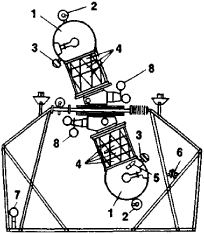planetarium
planetarium
(plan-ĕ-tair -ee-ŭm) An optical instrument by means of which an artificial night sky can be projected onto the interior of a fixed dome so that the positions of the Sun, Moon, planets, stars, etc., may be shown and their motions, real or apparent, demonstrated. The instruments were first built by the German firm of Carl Zeiss from 1913. The term also refers to the building housing such an instrument. Originally, planetarium was the name given to the device that later became known as an orrery.planetarium
[‚plan·ə′ter·ē·əm]Planetarium
(1) An apparatus for projecting images of fixed stars, the sun, the moon, and planets onto a hemispherical domelike screen. The first optical planetarium was designed by the German engineer W. Bauersfeld and was completed in 1924; it was built at the optical works of the firm of Carl Zeiss in Germany. In the 1970’s the Carl Zeiss people’s firm of the German Democratic Republic manufactures three models: the Zeiss Large Planetarium, the Spacemaster for demonstrating spaceflight, and the Zeiss Small Planetarium. Planetariums are also produced in the USA by Spitz, in Japan by Goto, and in the Federal Republic of Germany by Zeiss.
The Large Planetarium has the greatest demonstrative capabilities. It can show all stars down to a stellar magnitude of 6.5. In the present models, the 20 brightest stars have colors corresponding to their spectral classes. The star projectors are globes, one of which projects the stars of the northern celestial hemisphere, and the other the southern. Each sphere has about 16 openings, in which plates made out of metal foil are located. Each plate has up to 200 tiny holes, whose relative positions correspond to those of stars in the sky. The apparatus is also equipped with a Milky Way projector. A globe of smaller diameter projects the names of the constellations. There are also projectors for the sun, the moon, and the five planets visible to the naked eye—Mercury, Venus, Mars, Jupiter, and Saturn. The apparatus has more than 100 projector lamps and a number of electric motors, by means of which diurnal, annual, precessional, and meridian motion can be simulated. Its diurnal motion, which corresponds to the apparent diurnal motion of the celestial sphere, can be accelerated: a rotation can be performed in one to four minutes. The slow shifts of the sun and planets against the stellar background in annual motion can also be speeded up: an entire year can be shown in one minute. The precessional cycle, which in actuality is about 26,000 years, can be acclerated to about 1.5 minutes. Through motion along the meridian the stars can be shown from any geographic latitude on the earth—from the north to the south poles. Special devices project against the stars the celestial equator, the ecliptic, the celestial meridian, and other points and lines of the celestial sphere. There are projectors for auroras, comets, meteors, meteor showers, solar and lunar eclipses, and other celestial phenomena. A schematic diagram of a planetarium projector is given in Figure 1.

When used with the appropriate panoramas, a planetarium can show not only the terrestrial sky, but also the sky as seen from the moon, Mars, or Venus.
The Spacemaster planetarium is capable of showing the celestial sphere as seen from a spacecraft flying on a course inclined at any angle to the equator.
(2) A scientific educational institution at which popular lectures on astronomy, astronautics, and earth sciences are given. The lectures are accompanied by demonstrations of an artificial sky with the sun, stars, planets, satellites, and various spacecraft. Planetariums may also demonstrate auroras, comets, and meteors; solar and lunar eclipses; panoramas of the moon, Mars, and Venus; and the climatic belts of the earth. The projection equipment of the planetarium is used for these purposes.
The first planetarium was set up in Munich in 1925. The first planetarium in the USSR was opened in Moscow on Nov. 5, 1929. In 1974 planétariums were operating in 62 cities of the USSR.
The Moscow Planetarium is the largest center in the country for the popularization of nature science. An important part of the planetarium’s work is the propagandization of the materialist world view and scientific atheism, the analysis and generalization of methods for popularizing natural science, and the creation of unique demonstration devices. Many planétariums have “astronomical areas” equipped with telescopes and other devices for demonstrating various astronomical, physical, and geophysical phenomena. Astronomical clubs are connected with many planétariums; in these clubs schoolchildren learn how to use telescopes and to analyze observations and calculations.
Large planétariums exist in many foreign countries: 26 in North America, seven in South America, 19 in Europe (not counting the USSR), ten in Asia, two in Africa, and one in Australia.
REFERENCE
Bazykin, V. V., and V. K. Lutskii. Moskovskii planetarii, 2nd ed. Moscow, 1956.Bazykin, V. V., and I. F. Shevliakov. Metodika ispol’zovaniia apparata “Planetarii.” Moscow, 1963.
Portsevskii, K. A. Organizatsiia astronomicheskoi ploshchadki pri planetarii. Moscow, 1970.
Letsch, H. Das Zeiss-Planetarium, 4th ed. Jena, 1955.
Letsch, H. Captured Stars. Jena, 1959.
K. A. PORTSEVSKII